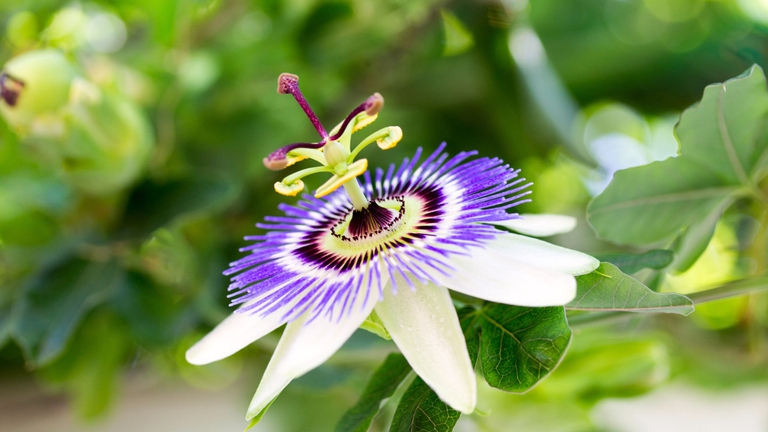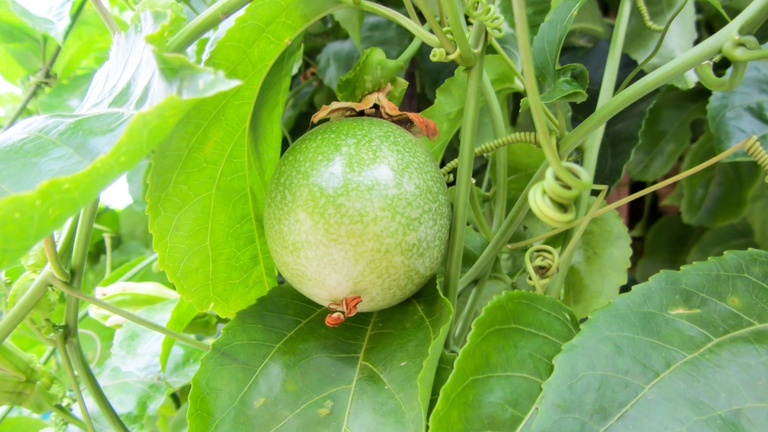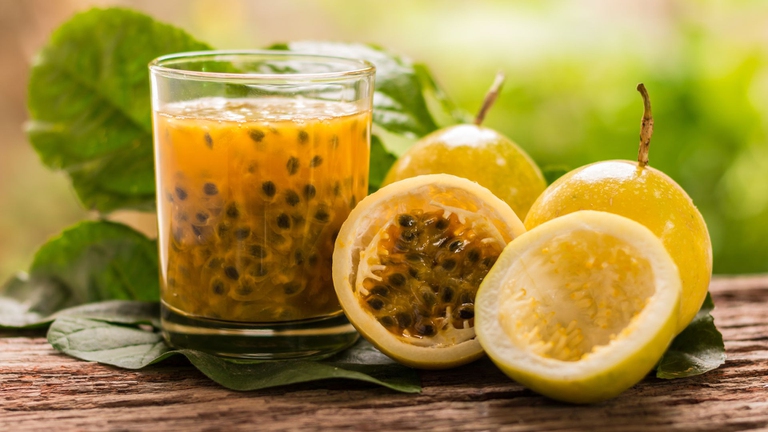https://www.lifegate.it/frutto-della-passione
- |
- Passion fruit comes from Passiflora edulis and is also known as maracuja.
- Its properties are multiple and documented, and concern the antioxidant, anti-inflammatory and antimicrobial action of the fruit.
- Maracuja is suitable for the preparation of delicate dishes, revealing a certain versatility.
- For some years, passion fruit has also been cultivated in Sicily, Calabria, Campania and Puglia.
Passion fruit is derived from Passiflora edulis, a climbing species native of Brazil and belonging to the Passifloraceae family.Several centuries ago, its flowers symbolized the passion of Christ:hence the usual name that is still used today.Also known as maracuja, this fruit has peculiar and exotic features, outlined by the rigid casing and the pulp rich in edible seeds.The latter boast a particular acidic aroma, containing, like the fruit as a whole, widely documented beneficial properties.

Nutritional values of passion fruit
A standard quantity of 100 g of passion fruit contains almost 73 g of water and has an energy value of 97 kcal.The carbohydrate intake is 23.4 g, for a simple sugar content of 11.2 g.The proteins, of low biological value, amount to 2.2 g, while the lipid fraction, which is negligible, corresponds to 0.7 g.Interesting fiber intake, in quantities of 10.4 g.
Among the micronutrients they stand out vitamin C and vitamin A, in the quantities, respectively, of 30 mg and 64 µg.Some minerals should also be highlighted, such as magnesium (29 mg), potassium (348 mg), iron (1.6 mg) and zinc (0.1 mg).
Passion fruit and beneficial properties
The properties of passion fruit (and the purple variety, specifically) have been investigated on a scientific level.In vitro studies, in particular, suggest interesting antioxidant properties, anti-inflammatory and antimicrobial.As regards the antioxidant potential, the investigations were carried out on the peel, pulp and seeds of the fruit, using different extraction methods. Antioxidant activity, aimed at limiting the accumulation of free radicals in cells, is attributed to various bioactive substances, which include phenolic components, carotenoids and sterols.
Laboratory experiments with cellular models, performed on the pulp of the fruit, have highlighted rather marked anti-inflammatory effects.These effects are correlated to the biological activity of the phenolic components and, in particular, of ferulic acid and epigallocatechins.The in vitro studies on antimicrobial properties of the fruit.The tests carried out on the peel extracts have shown a marked antibacterial activity on various species, such as Escherichia coli, Listeria monocytogenes, Staphylococcus aureus and Salmonella typhimurium.Also worth highlighting is theantifungal activity, demonstrated on the species Aspergillus niger, Penicillium funiculosum and others.Furthermore, the seed extracts have shown antimicrobial power against the bacterium ofacne, Propionibacterium acnes (or Cutibacterium acnes), with a higher inhibitory activity for the more concentrated extracts.

Clinical investigations on various types of patients, as well as further laboratory experiments, attribute it to passion fruit different therapeutic properties.The conditions studied, specifically, include some chronic pathologies, such as arterial hypertension, asthma, diabetes and osteoarthritis.The evidence mostly refers to extracts obtained from the peel, whose oral administration, in pre-established dosages, has been associated with the improvement of pathological conditions.In patients with hypertension, reduction in blood pressure values (diastolic and systolic) was observed.While in subjects suffering from asthma and osteoarthritis aalleviation of disease symptoms.Finally, in diabetic patients, a reduction in fasting blood sugar values has been highlighted.Overall, the highlighted beneficial effects are attributed to the antioxidant and anti-inflammatory activities of the extracts, with particular reference to their content of flavonoids.In any case, these are partially investigated properties, which require further clarification on the underlying molecular mechanisms.
Thanks to the related contribution of vitamin C, the consumption of this fruit lends itself to supporting the immune system.Furthermore, the resulting share of fiber becomes functional for the purposes of intestinal regularity.
How many passion fruits to consume
Generic consumption of fresh fruit, according to the guidelines for healthy eating, includes a portion of approximately 150 g, to be inserted two or three times during the day.The same criterion can be extended to passion fruit, although it is preferable to alternate the consumption of the various seasonal products.
Uses in the kitchen
By virtue of its characteristics of consistency, color and aroma, passion fruit is suitable for imaginative and innovative preparations.Among the most common recipes are undoubtedly desserts, which include puddings, semifreddos and reinterpretations of the classic tiramisu and cheesecake.The starters and seafood main courses offer other interesting possibilities.In the form of a sauce, passion fruit pairs effectively with salmon and tuna, in raw, smoked or baked versions.But the combination is also a winning one with prawns, whether marinated, steamed or fried.In a more or less conventional way, among other things, the seeds of the fruit are adaptable to salads of various types.
But let's get to the big exception: the peel.Not very pleasant if consumed as is, it is instead a good ingredient if ground and reduced to powder. Used as a spice, the peel can give aroma to homemade jams and biscuits, but also to smoothies, centrifuged drinks, fruit cocktails and herbal teas.

Contraindications and adverse effects
Although not numerous, the contraindications associated with the consumption of this fruit are worthy of note.Due to the relative contribution of some protein components, known as chitinases, passion fruit is contraindicated in case of latex allergy, for reasons of cross-reactivity.
Passion fruit juice and, in particular, that of the yellow variety, showed the content of cyanogenic glycosides.It's about toxic substances for humans, correlating with dizziness, weakness and gastrointestinal symptoms.Normal quantities of juice consumption, however, do not allow the toxicity threshold to be exceeded, proving to be essentially safe.
In more or less abundant quantities, passion fruit can reveal itself a laxative food, although some subjectivity applies.
Passion fruit, environment and health
The importation of exotic products, such as passion fruit, is associated with significant environmental problems.Just think of the transport routes, sometimes quite long, and the inevitably related CO2 emissions.But it doesn't end here.Importing plant products from remote countries means undergoing treatment and conservation methods that are not always compatible with those in force in Italy.Pesticides and preservatives with documented toxicity could contaminate our diet, representing a non-negligible risk to health.The passion fruit, however, has become part of "local" products, presenting a certain adaptability to some climatic areas of our country.The southern regions, and therefore Calabria, Sicily, Puglia and Campania, boast an interesting cultivation of maracuja.This has a positive impact on the extent of CO2 emissions, as well as on fruit marketing procedures.
FAQs
- What is passion fruit good for?Rich in fiber, passion fruit lends itself to intestinal well-being.It also contains important micronutrients, such as vitamin C, whose intake promotes the body's natural defenses.It is also a food with a strong antioxidant and anti-inflammatory power, making it useful for general health.Finally, its consumption is suitable for the diet of hypertensive and diabetic patients.
- How do you eat passion fruit? The seeds and pulp constitute the edible part of the fruit, although the peel can also be consumed, after grinding.Generally speaking, we proceed with the extraction of the internal fraction, which can be consumed as is or used in various recipes.The most popular preparations are the desserts, but the fruit is also suitable for the preparation of condiment sauces, useful for enriching second courses.
- How many passion fruits can you eat per day?The guidelines for healthy eating suggest the consumption of two or three servings of fruit a day, where each portion corresponds to approximately 150 g.Passion fruit can fit into this scheme, although it is preferable to alternate the consumption of the various seasonal products.
- What to do with passion fruit peel?The passion fruit peel can be ground and reduced to powder, and then used in the preparation of jams, smoothies, homemade biscuits, etc.
- What does passion fruit taste like?Passion fruit features a decidedly acidic and citrus aroma, although there is no shortage of sweetish notes.
- Where is passion fruit grown in Italy? Sicily, Calabria, Puglia and Campania are the Italian regions where the climatic conditions favor the cultivation of maracuja.
